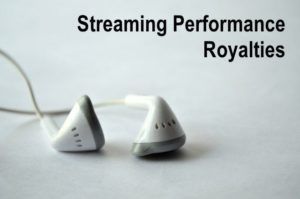The Streaming Performance Royalty Rate Explained
![]()
 Artists and songwriters, even some publishers, very often misunderstand how streaming income and royalty rates and payments are determined because it’s a immensely complex subject. One of the things that I’ve done in my new Music 4.1 book is provide an overview of how streaming royalties work and are paid, in many cases following the revenue stream down to the last $0.001. Here’s an except from the book explaining how the streaming performance royalty rate for songwriters is determined, since that’s the area that’s frequently quoted in articles and more often than not blown out of proportion. We’ll also introduce a brand new royalty that only applies to on-demand streaming services like Spotify called the streaming mechanical.
Artists and songwriters, even some publishers, very often misunderstand how streaming income and royalty rates and payments are determined because it’s a immensely complex subject. One of the things that I’ve done in my new Music 4.1 book is provide an overview of how streaming royalties work and are paid, in many cases following the revenue stream down to the last $0.001. Here’s an except from the book explaining how the streaming performance royalty rate for songwriters is determined, since that’s the area that’s frequently quoted in articles and more often than not blown out of proportion. We’ll also introduce a brand new royalty that only applies to on-demand streaming services like Spotify called the streaming mechanical.
“The Performance Royalty
Just like when it’s played over the radio, when a song is streamed, a performance royalty is generated. It’s almost always collected by one of the performing rights organizations (PROs), like ASCAP or BMI, and then distributed to the publishing company and songwriter.
Performance Royalty Rate Variables
There are a staggering number of variables when it comes to the different performance rates paid on a stream because there are a lot of different streaming services, and each has a slightly different way of determining the royalty it must pay. Just this section alone could take up at least several chapters, but because this isn’t a book on publishing, here are some of the situations you should know about where the performance royalty rate might vary, along with a short explanation of each:.
- On-Demand Nonportable—Subscription services accessible via desktop computers that only play music when a live Internet connection exists.
- On-Demand Nonportable Mixed Use—Subscription services accessible via desktop computers that can play music whether the computer is online or offline.
- On-Demand Portable Mixed Use—Subscription services accessible through portable devices, like mobile phones.
- On-Demand Bundled Subscription—Subscription sold together with another product (like a cellphone) for one price.
- Free Nonsubscription Ad-Supported Services—Services that offer streaming music to end users for free.
- Paid Locker Services—Services that provide continuous access for Internet-connected devices to recordings previously purchased by the end user.
- Purchased Content Locker—Services offered for free to purchasers of permanent digital downloads, ringtones, or physical records from a qualified seller that allows the purchaser access to digital versions of the purchased content from an Internet-connected device.
- Limited Offering Subscription—Subscription services that offer a very limited catalog of music (like from a particular genre or playlist), or services that offer streams of preprogrammed playlists.
- Mixed Service Bundle—The sale of downloads, ringtones, locker services, or limited offerings together with nonmusic products (like a cellphone or Internet service) for one price.
- Music Bundle—The sale of two or more products together for one price, like a CD, digital download, and ringtone.
- Foreign On-Demand Free Tier—The payment received from a foreign PRO on streams from an on-demand service’s free tier.
- Foreign On-Demand Subscription Tier—The payment received from a foreign PRO on streams from an on-demand service’s paid tier.
- Foreign Webcast Free Tier—The payment received from a foreign PRO on streams from a noninteractive service’s free tier.
- Foreign Webcast Subscription Tier—The payment received from a foreign PRO on streams from a noninteractive service’s paid tier.
- Satellite Radio—The payment received from SiriusXM streams.
- Cable Television—The payment received from the music-only channel streams offered by cable television providers.
The average composition royalty rate per stream is around $0.0005, according to Audiam.
In the case of on-demand streaming services like Spotify or Apple Music, there’s an additional royalty generated on the composition called a streaming mechanical.
The Streaming Mechanical Royalty
The streaming mechanical royalty is relatively new and was created on the premise that on-demand streaming closely resembles a permanent download because the user has such a high level of control.
When the Copyright Rate Board ruled in 2008, it mandated that the streaming mechanical rate would be around 21 percent of what’s paid to the record label for the sound recording if paid directly to the publisher, or around 18 percent if paid to the record label (depending on a set of variables too deep to get into here). That means that the average streaming mechanical rate per stream is somewhere around $0.0067, according to the digital music accounting firm Audiam. As a general rule, the owners of a sound recording often end up with five or six times more revenue than the owner of the musical composition on a particular song stream.“
As you can see, there’s a huge number of variables when it comes to royalty rates paid to songwriters, and they each pay at a slightly different rate. That’s why whenever you read a figure about how much a stream pays you have to remember that it’s usually an average, and might not apply to your particular situation. Remember, we’re talking royalties only paid to songwriters here, and not to artists, which is a separate subject. In the coming weeks, we’ll look at other aspects of online streaming royalties that you probably won’t see anywhere else.
You can read more from Music 4.1: A Survival Guide For Making Music In The Internet Age and my other books on the excerpt section of bobbyowsinski.com.
(Photo: courtesy of PDPics.com)


